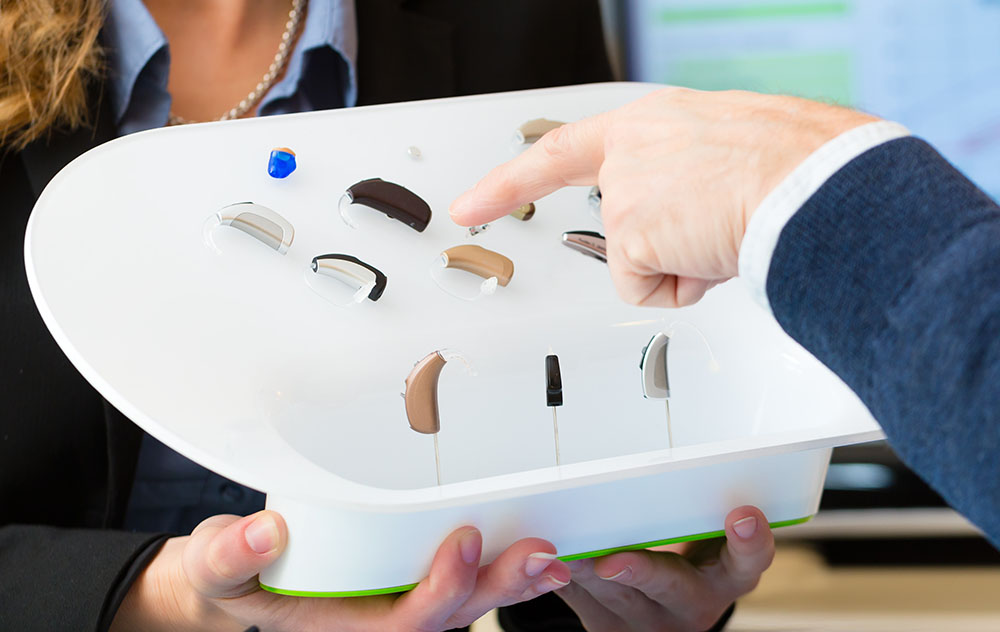Following a diagnosis of hearing loss, you will talk with your audiologist about the best hearing aids to address your needs. However, you may find that the sheer range of options available is somewhat overwhelming, and the terminology surrounding the different styles can be more than a little confusing.
To add a little extra clarity to your decision-making, below, we’ve provided background information on the different hearing aid styles, as well as a few tips to help you determine which may be most suitable for you.
The styles of hearing aids
First, let’s provide an overview of the most common hearing aid styles:
- Behind-the-ear (BTE) hearing aids: BTE hearing aids are perhaps the most recognizable type of hearing aid. The device sits behind the ear (as one would expect) with a sound-carrying tube hooking over the front of the ear. The most significant benefits of BTE hearing aids are that they are suitable for most types of hearing loss, ranging from mild to profound and that their larger size is conducive to longer battery life. The most significant downside of BTE hearing aids is that the device is rather conspicuous and obvious in the ear.
- In-the-ear (ITE) hearing aids: ITE hearing aids enclose all of the working components into a single piece, which then sits over the bowl of the ear. ITE hearing aids are suitable for mild to moderate hearing loss. The most significant benefit of ITE hearing aids is the sound quality they can provide thanks to dual microphones; many individuals also prefer ITE hearing aids for their discreet style. The most notable downside people observe when using ITE hearing aids is that they tend to require more maintenance; due to the close proximity to the ear canal, earwax and moisture can be problematic.
- In-the-canal (ITC) hearing aids: ITC hearing aids are very discreet devices that sit inside the ear canal; they are primarily used to treat mild or moderate hearing loss. This discretion is arguably the most notable benefit of ITC hearing aids, though users also comment on the excellent sound quality and comfort. The biggest downside of ITC hearing aids is that their small size can mean that their battery life is reduced. Furthermore, there are also sub-types of ITC hearing aids, including invisible in canal (IIC) hearing aids, which function in much the same way as the more common ITC options but offer even greater discretion.
Tips for choosing the right hearing aids for you
It is important to note that your audiologist is the best source of advice regarding hearing aids, as they can use their expertise and knowledge of your hearing loss to make a recommendation as to which type of hearing aid is most suitable for you. However, there are a few factors you may want to consider alongside your audiologist’s advice:
- Be guided by your level of hearing loss: The most important consideration when choosing hearing aids is to find a device that is suitable for your level of hearing loss. As we discussed in the overview above, different styles of hearing aids are ideal for all levels of hearing loss, while others are better suited to mild or moderate hearing loss. While there are undoubtedly other considerations to keep in mind, ultimately, your hearing aid needs to function for its core purpose, so finding a device capable of treating your specific level of hearing loss should always be the primary goal.
- Decide your priority: When choosing hearing aids, your preferences are of utmost importance. For some people, finding a hearing aid that offers discretion is an essential factor; for others, longer battery life or simpler maintenance is far higher on their priority list. As a result, it’s helpful to establish a priority order for factors such as battery life, discretion, maintenance, and features, so you can narrow your search to hearing aids that are compatible with your personal preferences.
- Consider features and programs: The vast majority of hearing aid devices will provide more than simple amplification; a range of programs and features, such as Bluetooth compatibility and tinnitus masking, are also available. It can, therefore, be helpful to use features and programs as a “tiebreaker” between two devices, opting for the device that offers a range of functionalities that are most suited to your lifestyle and needs.
Learn more today
To learn more about Tops Hearing & Balance Center, please do get in touch today at (281) 920-3911. We are ready to deal with any query you may have.



